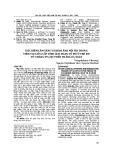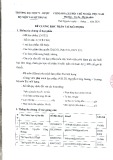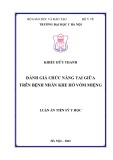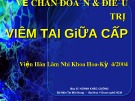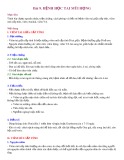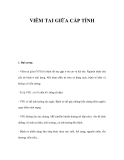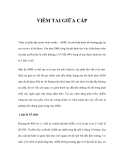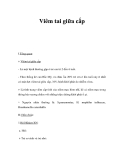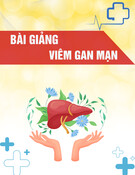́
́
́
̃
ƯƠ
́
́
́
̃
ƯƠ
TO M TĂ T H
NG DÂ N
TO M TĂ T H
́ ́
V ỀV Ề CHÂN ĐOA N CHÂN ĐOA N
̉ ̉
NG DÂ N ̀ ̀ ĐIÊ U && ĐIÊ U TRI ̣TRI ̣ CẤP IÊM TTAI AI GGiỮAiỮA CẤP
VVIÊM
Vi nệVi nệ Hàn Lâm
Hàn Lâm Nhi Khoa
ỳ ỳ HoaK 4/2004 Nhi Khoa HoaK 4/2004
Bác Sĩ HÙYNH KHẮC CƯỜNG
Bộ Môn Tai-Mũi-Họng – Đại Học Y Dược tphố HCM
ACUTE OTITIS MEDIA ACUTE OTITIS MEDIA
ặ ấ
ề Đ t V n Đ Guidelines
Lạm dụng chẩn đóan và trị liệu bệnh VTG cấp
Tỷ lệ kháng thuốc kháng sinh ngày càng tăng
Y học chứng cứ (74 randomized trials _ 760 ref)
AAP phối họp cùng với AAFP công bố 4/2004,
được AAOH&NS nhất trí vào tháng 1/2005
Áp dụng đ/v trẻ khỏe mạnh từ 2 tháng – 12 tuổi
Đề cập đến VTG cấp không biến chứng
̃ư
ắ
Nh
Th c M c
ắ ng Chi nh́
1. Chẩn đoán chính xác VTG cấp tính ??
2. Giảm đau : có cần thiết không ??
3.
Theo dõi “watchful waiting” hay dùng thuốc kháng sinh ngay tức thời ??
4. Phòng ngừa VTG cấp : risk factors ??
5. Di chứng hậu quả VTG ??
6. Chọn thuốc nào thích họp nhất ??
7. Kháng sinh liệu pháp ngắn hạn (3–5 ngày) ??
What is acute otitis media?
Sudden onset, short duration <48hours Tympanic membrane has abnormal
appearance ANDAND
Presence of fluid in the middle ear, or
purulent otorrhoea
At least one symptom or finding
indicative of acute generalised infection
ị
́ CHI NH
Đ NH NGHĨA XA Ć
3 TIÊU CHUẨN =
– Khởi phát đột ngột ≤ 48giờ
– Tiết dịch trong hòm nhĩ
– Tình trạng viêm phù nề
sung huyết của màng nhĩ
ĐiỀU KIỆN SINE QUA NON =
nhất thiết phải có middle ear effusion
Clinical diagnosis of otitis media
History and symptoms
Tympanic membrane findings with pneumatic otoscope and tympanometry or acoustic reflectometry (if available)
́
́
́
CHÂN ĐOA N CHI NH XA C
̉
Tympanic membrane findings
Karma 1993 và Pelton 1998
Impaired mobility // bulging : 85-99% PPV
Tympanic membrane bulging : 83-99% PPV
Tympanic membrane is red, translucent or
yellowish : 7% PPV (!)
Often unilateral findings
Ớ
Ố
GIAM ĐAU
S M CÀNG T T
paracetamol 15-20mg/kg qid
ibuprofen 10mg/kg tid
naproxen 5mg/kg bid
̉
Otipax® ear drops with (C) !! local anaesthetic (C) !!
decongestants
postural treatment
́
́ THEO DÕI va ̀ QUAN SA T ̀ KHÔNG DU NG KHA NG SINH Tuổi, mức độ nặng và chẩn đoán xác định
Theo dõi sát
Không > 48-72 giờ
́
́ THEO DÕI va ̀ QUAN SA T ̀ KHÔNG DU NG KHA NG SINH
Tuổi
▲ (+)
▲ (±)
< 6 tháng Kháng sinh Kháng sinh
6-2 tuổi Kháng sinh Quan sát nếu không nặng
>2 tuổi Quan sát Quan sát nếu không nặng
Aetiology of otitis media
bacteria isolated in 70% of cases virus isolated in about 20% of cases
Main bacteria :
1. Streptococcus pneumoniae 2. Haemophilus influenzae 3. Moraxella catarrhalis
Ọ
Ẩ VI KHU N H C
Strep. pyogenes 5%
Other 6%
Vi trùng : S. pneumoniae,
No growth 6%
Moraxella catarrhalis 14%
H. influenzae và M. catarrhalis
Strep. pneumoniae 50%
Tỷ lệ phế cầu vẩn cao
Haemophilus influenzae 19%
Tỷ lệ vi khuẩn sinh men
beta-lactamase ngày càng nhiều
Betalactam resistance in Asia Alexander Project 2000 – GlaxoSmithKline data on file
Russia 3.1% 0.0%
Japan 20.2% 30.9%
USA 10.7% 22.7%
Hong Kong 3.6% 71.4%
Mexico 36% 17.5%
Saudi Arabia 31.2% 24.7%
Singapore 12.2% 32.6%
Brazil 13.4% 3.0%
South Africa 36.3% 15.4%
Penicillin-intermediate (MIC 0.12–1 µg/mL) Penicillin-resistant (MIC >2 µg/mL)
Betalactam resistance in Asia Song JH & ANSORP – personal communication ANSORP Project 2000–2001
80
71
685 invasive isolates from 11 Asian countries
70
60
55
50
40
30
%
20
P R S P
10
0
g
d
n
m
n
o
a n k a
p
o r e a
aila
a
g K
ala y sia
K
h
g
n
T ai w a n
V iet n a
T
M
o
o r e S ri L
C hin a S i n
H
Philippines India
S a u di A ra bia
(Penicillin MIC >2 mg/L)
́
KHA NG SINH
BAN ĐÂ Ù
Amoxicillin 80-90mg/kg/ngày, chia uống làm
2 lần, nếu không có dấu hiệu nặng
Amoxicillin (90 mg/kg) + clavulanate (6,4
mg/kg) nếu có dấu hiệu nặng
VTG cấp nặng = nếu >390C và nhức tai (++)
̀
Amoxicillin liê u cao
8090
mg/kg
Nồng độ thuốc trong dịch tai giữa đủ cao :
– diệt tất cả những dòng S. pneumoniae nhạy
và không nhạy với PNC
– diệt những dòng có MIC đ/v PNC từ
0,8-1,2μg/ml, >2 μg/ml và thậm chí 8 μg/ml
Chia làm 2 lần uống trong ngày (bid)
́
̣ Ư
́ Ơ S DI NG V I BETALACTAM TMP/SMX và ERY/SULF : du ng̀ ế h n chạ
Type I (IgE)
Non-type I
Azithromycin
Cefdinir
Clarithromycin
Cefuroxime
Cefpodoxime
̃
́
̣ Ợ DIÊ N TIÊ N THUÂN L I
24 giờ đầu : ổn định triệu chứng
24 giờ tiếp theo : giảm các triệu chứng
Sau 72 giờ mà không cải thiện, thì phải đổi kháng sinh và xem lại chẩn đoán
́ ĐÔI KHA NG SINH
̉
Điều trị ban đầu
Thất bại sau 48-72 giờ
Quan sát
Amoxicillin 80-90 mg/kg
Amoxicillin liều cao
Amoxiclav
Amoxiclav
Ceftriaxone IM/IV 3 ngày
́ ĐÔI KHA NG SINH
̉
Điều trị ban đầu
Thất bại sau 48-72 giờ
Cefdinir
Cefuroxime
Ceftriaxone IM/IV 3 ngày
Cefpodoxime
Azithromycin
Clindamycin
Clarithromycin
Ceftriaxone IM/IV 3 ngày Trích rạch màng nhĩ
̀Ơ
TH I GIAN
THEO DÕI
> 6 tuổi : 5 ngày
< 6 tuổi : 10 ngày
Khám mỗi 3 ngày khi còn triệu chứng cấp
Theo dõi 3-6 tuần sau khi hết triệu chứng
́
̀
̃
Tri ch Rach Ma ng Nhi
Cho phép chẩn đoán chính xác tác nhân vi
̣
khuẩn gây bệnh
Chỉ định :
– Thất bại với 2 loại kháng sinh liên tiếp
– Màng nhĩ phồng căng nhiều
– Tình trạng nhiễm trùng nhiễm độc nặng
Risk factors of otitis media
age <2 years (A) respiratory tract infection (A) day-care (A) family history (A) siblings (A) (passive) cigarette smoking (B) pacifier (C) short duration of breastfeeding or none (B)
Prevention of otitis media
No evidence or no data: No evidence or no data:
Adenoidectomy (-C) (-C) Decongestants and AH1
drugs (-C)
Evidence exists for: Evidence exists for: day-care cigarette smoke breastfeeding (+B) (+B) antibiotics (+B) (+B) Xylitol (+B) (+B) ventilation tubes (+B) (+B) immunisation:
Pneumococcal vaccine Influenza (+A) (+A) immunoglobulins (-B) (-B)
++ positive effect -- no effect
̀
́
ư
̀ Pho ng ng
a VTG câ p
Cho bú sữa mẹ trong 6 tháng đầu tuổi
Tránh tư thế nằm ngửa khi bú bình
Tránh cho ngậm núm vú cao-su
Tránh khói hút
thuốc lá
́
̀
̃ư
Nh
ph
ng
̣
ươ ca ch điê u tri
ng kha ć ( Alternative Medicine )
Châm cứu
Thảo dược
Bổ sung dinh dưỡng
Xoa bóp (chiropratic treatment)
Không chứng cớ được !!
Consequences of Otitis Media
NONSUPPURATIVE
SEQUELAE
• TM atelectasis
Acute Otitis Media
• Adhesive OM
• Cholesteatoma
Chronic Otitis Media With Effusion (OME) •Mucoid OM •Secretory OM
• Ossicular erosion /
fixation
SUPPURATIVE
• Hearing loss
COMPLICATIONS
• Conductive
• Chronic suppurative OM
• Sensorineural
• Mastoiditis
• Meningitis
• Facial nerve palsy
TakeHome Points
1. Chẩn đoán chính xác VTG cấp qua otoscopy
2. Giảm đau sớm là cần thiết
3. Theo dõi, khoan vội dùng kháng sinh ngay lập tức = “delayed prescription of antibiotics for most URT infections seems to be safe” (Sharland BMJ 331:328-329 August 2005)
4. Phòng ngừa = khống chế các risk factors
5. Amoxicillin liều cao (80-90mg/kg bid)
Why focus AOM therapy on Pneumococcus?
Most common initial bacterial pathogen
Most common isolate after failed therapy
Least likely bacterial organism to self-resolve
Most likely to cause severe otitis media
Most likely to cause suppurative
complications of otitis (mastoiditis)
Pneumococcal resistance
Two mechanisms of resistance
• most common mechanism in USA • MICs moderate e.g 8mcg/ml
– Efflux pump
• macrolides and clindamycin • MICs high >256mcg/ml
– Ribosomal
Is Amoxicillin the best initial agent for AOM?
•
Initial therapy should focus on DRSP, as H. influenzae and M. catarrhalis are less common than S. pneumoniae and more likely to resolve spontaneously
• Amoxicillin is the most active of commonly used oral
antibiotics against DRSP
• Recommended for initial therapy at high (80-90 mg/kg)
doses – high dose if prior abx, day care or other risk factors
• But why does amoxicillin sometimes fail?
How effective is high dose (90mg/kg/d) amoxicillin* against pneumococcus?
Bac t e r ial e r ad ic a t io n
10 0 % ( 6 1 o f 6 1)
Pne um o c o c c al s us c e p t ib ilit y S e ns it ive MI C < 0 .0 6
10 0 % ( 2 1 o f 2 1)
I nt e r m e d iat e MI C 0 .1 1.0
9 3 .5 % ( 2 9 o f 3 1)
Re s is t ant MI C > 2
Dagan et al. Poster 107, ICAAC 2000 *Study done with amoxiclav, but clavulante has no activity against pneumococcus
Time above MIC: Best Predictor of Bacterial Eradication for β-lactams
16
8
4
Serum Conc. (ug/ml)
2
1
MIC 1.0 ug/ml
0.5
4.56 hrs
4.56 hrs
0.25
0.125
> 40 % of dosing interval
Time (hrs)
0 24 12 hr
MEF amoxicillin concentration after oral dose of 25mg/kg in AOM Some children do not achieve predicted MEF levels
Canafax PIDJ 1998;17:149156
An alternative approach
As amoxicillin is the most active oral
betalactam against DRSP, other classes
of antibiotic should be considered after
treatment failure with high-dose
amoxicillin
Ceftriaxone IM: 50 mg/kg
Peak 70 ug/ml
12 hr/ 24 hr = 50% 12 hr/ 24 hr = 50%
Conc. (ug/ml)
10
S. pneumoniae MIC 2.0 ug/ml
1
12 hours
0.1
0 24 12 hr
Selection of antibiotic after high-dose amoxicillin failure: focus on pneumococcus
Macrolides/Azalides as alternative second-line agents • Different mechanism of pneumococcal resistance – resistance not mediated by penicillin binding protein • Despite cross-resistance, many penicillin-resistant
strains are fully susceptible to macrolides – 65% of intermediate resistant and 40% of penicillin-resistant
strains remain fully susceptible to macrolides in USA*
– Likely activity of 30mg/kg azithromycin single dose therapy
• Efflux resistance more common in USA
against many efflux resistant strains
*Whitney NEJM 2000;343:1917-24
Single dose azithromycin vs. 10 day amoxicillin/clavulanate
C ur e d o r I m p r o ve d
1 0 0 %
8 0 %
8 6 %
8 8 %
7 5 %
7 5 %
6 0 %
A z it h r o m y c in
4 0 %
A m o x / c la v
2 0 %
0 %
Eva lua b le a t 1 2 1 6
Eva lua b le a t 2 8 3 2
d a y s
d a y s
Block SL et al. Poster 174 ICAAC 2000

